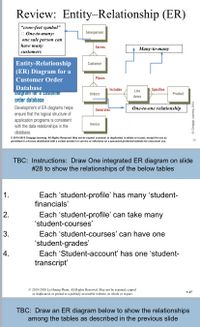
Database System Concepts
7th Edition
ISBN: 9780078022159
Author: Abraham Silberschatz Professor, Henry F. Korth, S. Sudarshan
Publisher: McGraw-Hill Education
expand_more
expand_more
format_list_bulleted
Concept explainers
Question

Transcribed Image Text:**Review: Entity–Relationship (ER)**
**Entity-Relationship (ER) Diagram for a Customer Order Database**
**Diagram Explanation:**
- **Salesperson**: Connected with a "crow-feet symbol" indicating a one-to-many relationship, meaning one salesperson can have many customers.
- **Customer**: Connected to "Salesperson" and "Orders". It serves as a bridge between salespeople and orders.
- **Orders**: Placed by customers and includes "Line items."
- **Line items**: Specifies the products on the order and forms a many-to-many relationship with "Product."
- **Product**: Detailed in "Line items."
- **Invoice**: Generated from the orders, forming a one-to-one relationship.
*Development of ER diagrams ensures that the logical structure of application programs is consistent with the data relationships in the database.*
---
**Instructions:**
Draw one integrated ER diagram to show relationships among the tables described:
1. Each ‘student-profile’ has many ‘student-financials.’
2. Each ‘student-profile’ can take many ‘student-courses.’
3. Each ‘student-courses’ can have one ‘student-grades.’
4. Each ‘Student-account’ has one ‘student-transcript.’
*Please draw an ER diagram to show the relationship among the tables as described above.*
Expert Solution
This question has been solved!
Explore an expertly crafted, step-by-step solution for a thorough understanding of key concepts.
This is a popular solution
Trending nowThis is a popular solution!
Step by stepSolved in 2 steps with 1 images

Knowledge Booster
Learn more about
Need a deep-dive on the concept behind this application? Look no further. Learn more about this topic, computer-science and related others by exploring similar questions and additional content below.Similar questions
- In addition to a variable's name, its "type" and "extra characteristics" must be specified. That is to say, apart from its data type, every variable has its own distinct characteristics. If you could elaborate on the idea so that we could better clarify the terms, that would be great.arrow_forwardSolve the system using Design the Use Case Diagram (contains at least 10 use cases) (Example)arrow_forwardPractice Programming Planning Problems using Object Oriented Design– Outline the classes and relationships and describe the programming process for an "automatic meeting scheduler using inputs from a calendar database." Use a simplified version of Unified Modeling Language class diagram. You are not writing the code for this, just the design and the algorithm.arrow_forward
arrow_back_ios
arrow_forward_ios
Recommended textbooks for you
 Database System ConceptsComputer ScienceISBN:9780078022159Author:Abraham Silberschatz Professor, Henry F. Korth, S. SudarshanPublisher:McGraw-Hill Education
Database System ConceptsComputer ScienceISBN:9780078022159Author:Abraham Silberschatz Professor, Henry F. Korth, S. SudarshanPublisher:McGraw-Hill Education Starting Out with Python (4th Edition)Computer ScienceISBN:9780134444321Author:Tony GaddisPublisher:PEARSON
Starting Out with Python (4th Edition)Computer ScienceISBN:9780134444321Author:Tony GaddisPublisher:PEARSON Digital Fundamentals (11th Edition)Computer ScienceISBN:9780132737968Author:Thomas L. FloydPublisher:PEARSON
Digital Fundamentals (11th Edition)Computer ScienceISBN:9780132737968Author:Thomas L. FloydPublisher:PEARSON C How to Program (8th Edition)Computer ScienceISBN:9780133976892Author:Paul J. Deitel, Harvey DeitelPublisher:PEARSON
C How to Program (8th Edition)Computer ScienceISBN:9780133976892Author:Paul J. Deitel, Harvey DeitelPublisher:PEARSON Database Systems: Design, Implementation, & Manag...Computer ScienceISBN:9781337627900Author:Carlos Coronel, Steven MorrisPublisher:Cengage Learning
Database Systems: Design, Implementation, & Manag...Computer ScienceISBN:9781337627900Author:Carlos Coronel, Steven MorrisPublisher:Cengage Learning Programmable Logic ControllersComputer ScienceISBN:9780073373843Author:Frank D. PetruzellaPublisher:McGraw-Hill Education
Programmable Logic ControllersComputer ScienceISBN:9780073373843Author:Frank D. PetruzellaPublisher:McGraw-Hill Education

Database System Concepts
Computer Science
ISBN:9780078022159
Author:Abraham Silberschatz Professor, Henry F. Korth, S. Sudarshan
Publisher:McGraw-Hill Education

Starting Out with Python (4th Edition)
Computer Science
ISBN:9780134444321
Author:Tony Gaddis
Publisher:PEARSON

Digital Fundamentals (11th Edition)
Computer Science
ISBN:9780132737968
Author:Thomas L. Floyd
Publisher:PEARSON

C How to Program (8th Edition)
Computer Science
ISBN:9780133976892
Author:Paul J. Deitel, Harvey Deitel
Publisher:PEARSON

Database Systems: Design, Implementation, & Manag...
Computer Science
ISBN:9781337627900
Author:Carlos Coronel, Steven Morris
Publisher:Cengage Learning

Programmable Logic Controllers
Computer Science
ISBN:9780073373843
Author:Frank D. Petruzella
Publisher:McGraw-Hill Education